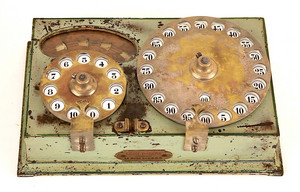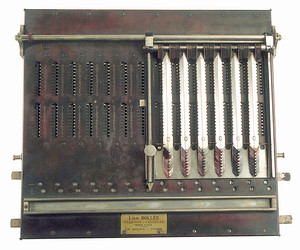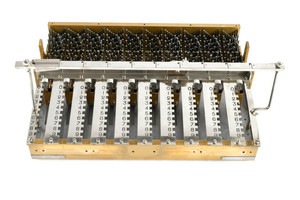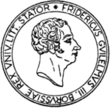Léon Bollée was an ingenious inventor who developed groundbreaking ideas for the construction of calculating machines at a young age. As the son of an old family of bell founders from Le Mans, France, he had the necessary workshop and technical training as a teenager to manufacture mechanically sophisticated prototypes in metal himself. 
Léon Bollée's turquoise adding machine (1893) with dial input from the Musée de Tessé in Le Mans, France. © Arithmeum
After constructing simple adding machines, he devoted himself mainly to the mechanization of multiplication. Initially, he worked with traditional ideas, such as those of John Napier and his so-called Napier's rods and a special reading table he designed himself which was not intuitive to use. These aids did not yet have a mechanical carry mechanism and initially only showed his intellectual approach to the subject.

Special arithmograph (1890) by Léon Bollée from the Arithmeum.
Léon Bollée then achieved his first breakthrough with his prototype. Here, he used multiplication tables for the first time, which stored the entire times -table mechanically. Once the multiplicand and multiplier had been set, they could be read off via sensing rods, and the correct result could be transferred immediately to a result mechanism. However, Bollée still seemed to struggle with the mechanical implementation of the tens carry and the effort required to manufacture the machine. So he left this prototype unfinished and devoted himself to building his award-winning direct multiplying machine, which won the gold medal at the “Exposition Universelle de Paris” in 1889. The Bollée calculating machine is very impressive, if only because of its dimensions, measuring over a meter in width and weighing over 80 kg. Bollée was satisfied with this design and produced several copies, one of which is on display at the Arithmeum and is kept at the Musée de Tessé in Le Mans. In preparation for the exhibition, we completely dismantled, cleaned, documented, and restored this machine so that its function can be experienced in the exhibition. With a few tricks, the machine can also be used to calculate roots. Despite the wonderful realization of his ideas, Bollée ultimately built only a few copies, as he soon became more fascinated by the construction of cars, such as the famous three-wheeled Voiturette, and airplanes. 
Detail: Bollée's setting mechanism and multiplication body. © Arithmeum
Individual tours, workshops, children's and school programs can be booked through the Arithmeum visitor service.
A catalog accompanying the exhibition is available.
A video about the inventor's life and work can be viewed here:
A german and french version of the video are available as well.






